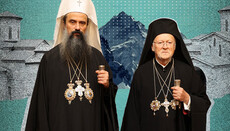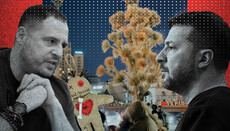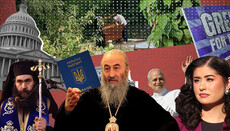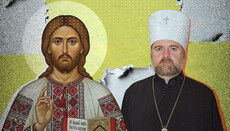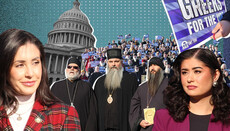Main Outcome of Amman Synaxis
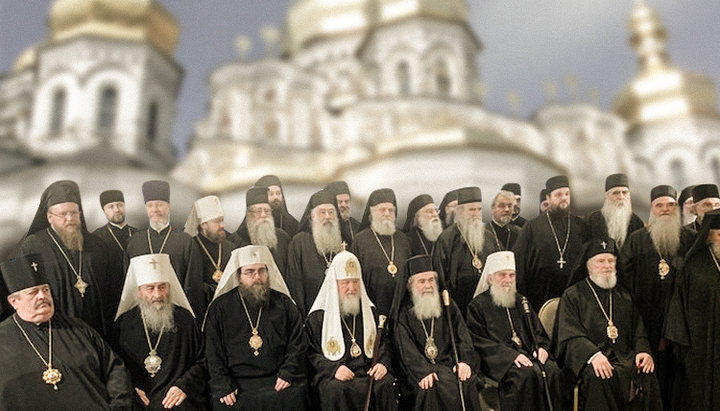
An analysis of the communiqué of the Primates’ Meeting in Jordan.
On February 26, 2020, in Amman, a Synaxis of Primates and Representatives of the Local Orthodox Churches was convened by Patriarch Theophilos of Jerusalem. In the evening of the same day, the final statement (communiqué) of the Meeting was published on the Web. What is in this document and what is not in it?
What is not in the Communiqué
Outspoken condemnation of Patriarch Bartholomew's actions.
Initially, it was clear that the leitmotif of the Primates’ gathering is illegal actions of Patriarch Bartholomew in Ukraine. All participants in the meeting repeatedly criticized the granting of the Tomos to the OCU both on a personal and official level (through the Synods of their Churches). They were also critical about the papal claims of Constantinople.
True, the format of the Amman meeting did not imply a direct condemnation of Patriarch Bartholomew. According to the canons of the Church, this can only be done at the Council, in compliance with procedural rules. Is such a scenario possible in the future? Undoubtedly.
Disagreement with Phanar’s having appropriated the right to grant autocephaly.
This also goes beyond the competence of the Amman Synaxis. First of all, because of its format.
The right to grant autocephaly was supposed to be considered at the Cretan Cathedral in 2016. According to the Head of the Department for External Church Relations of the Russian Orthodox Church, Metropolitan Hilarion (Alfeyev) of Volokolamsk, in the preparatory documents there were agreements on the procedure for granting autocephaly. So, under these agreements, the Cyriarchal Church (Mother Church) announces its desire to grant autocephaly to its part in the Patriarchate of Constantinople as the Church being the first in the Diptych. Constantinople sends notification to all Local Churches requesting for their consent, and in the case of the general agreement expressed by each of the Churches at its Council, the new autocephalous Church is accepted into the family of Local Churches having been granted the corresponding Tomos, which is signed by the Primates of all Local Orthodox Churches.
We emphasize once again that there was a preliminary agreement on the Tomos-issuance procedure, but it was not ratified – the topic was removed from the agenda of the Cretan Council. Therefore, Met. Hilarion says, "when this Council ended, Patriarch Bartholomew in fact declared these agreements not to be in place and began to unilaterally bestow autocephaly."
Today among the Local Churches there is no consensus on the approach to the right to grant autocephaly. Even among those who did not recognize the “autocephaly” of the OCU, there are Churches that do not dispute the right of Constantinople to grant autocephaly in general. For example, the Romanian or Albanian Churches.
Therefore, speeding up the decision could cause strong disagreements in the camp of opponents of the non-canonical actions of Patriarch Bartholomew in Ukraine. Anyway, there is no doubt that the Orthodox Churches will definitely return to this issue.
Condemnation of the Tomos for the OCU and Ukrainian schismatics.
The fact that Ukrainian schismatics can be accepted into the Church only through repentance or that only the Mother Church, i.e. The Russian Orthodox Church, can grant Autocephaly to the Ukrainian Church, has been reaffirmed many times. The mechanical granting of "autocephaly", signed by Patriarch Bartholomew without taking into account the situation in Ukraine, did not solve the problem of schism but only exacerbated it, which was noted by the Primate of the UOC Metropolitan Onuphry in an address to the participants in the Amman Meeting.
In addition, he emphasized that the granting of autocephaly to the canonical Church of Ukraine (UOC) will not solve the problem of the split in the country, since the UOC has autocephaly de facto: “Over time, the internal and external circumstances experienced by the Holy Ukrainian Orthodox Church and the Ukrainian people have stimulated the processes of improving the existing independence and self-government of church life and ministry. Today we have de facto real autocephaly. We have the Holy Synod, we have the Council of Bishops, we have an independent church court. We independently elect and ordain bishops, open new dioceses. We have our own spiritual educational institutions, various synodal institutions for interaction with the outside world and social ministry.”
Almost all participants in the Amman meeting hold the view that Ukrainian schismatics do not have canonical ordinations. The absence of such formulations in the communiqué, in our opinion, is caused by the reluctance to reject from the Church those who entered into communion with the OCU. But there is no doubt that the Church will definitely return to the issue of the canonicity of schismatic “consecrations”.
What is in the Communiqué
1. The role of Patriarch Theophilos in his “all the relentless efforts aimed at paving the way for dialogue and bringing brothers together in the precious spirit of unity” was emphasized. It is said that “Jerusalem stands as a witness to that Holy City which continuously proclaims its multi-faith and multicultural tapestry rejoicing in its existence as the warm home for the three Abrahamic faiths, Christianity, Judaism and Islam.”
This paragraph confirms that the Patriarch of Jerusalem has the full right to convene Orthodox Councils.
2. It was highlighted that “this gathering was to strengthen the fraternal bonds between brothers and their Churches, to promote the bonds of peace in Christ among them, to advocate for the unity of the Orthodox Churches, and to renew dialogue in the prayerful hope of bringing reconciliation where there has been discord.”
It is the renewal of dialogue that can be called the main thesis of the second paragraph. Naturally, the sensitive areas identified in the communiqué “where there has been discord” primarily concern the “Ukrainian issue”. Now there is practically no dialogue on it. Patriarch Bartholomew in every way demonstrates unwillingness or inability to engage in such a dialogue. His latest rhetoric, including with regard to the Amman meeting, only confirm the authoritarian and dictatorial nature of Phanar’s policy. Giving the cold shoulder to the call for dialogue from the representatives of the six Local Churches will cause not only bewilderment but also serious problems inside the camp of Phanar supporters.
The signature of Patriarch Kirill under the decisions of the Synaxis testifies that the Russian Orthodox Church is open to dialogue. But the dialogue should take place in the spirit of fraternal love and should not be dictated by the ambitions of the Patriarchate of Constantinople.
3. The participants in the Meeting “agreed that decisions concerning issues of Orthodox-wide importance, including the granting of autocephaly to particular Churches, should be finalised in a spirit of pan-Orthodox dialogue and unity, and with pan-Orthodox consensus.”
We have already said about the agreements regarding the right to grant autocephaly prior to the convocation of the Cretan Council. This paragraph states the desire to return to the discussion of the problem. There is also an implication of inappropriateness of the sole decisions having pan-Orthodox significance, the Church being intrinsically catholic (conciliar).
Apparently, Phanar either does not want to see and understand it or pretends not to remember about it. Therefore, the Amman participants were simply compelled to remind the Phanariots of the common ecclesiological truths.
4. Support was expressed for the Serbian Orthodox Church regarding Northern Macedonia and Montenegro.
The Macedonian schismatics have already made it clear several times that they are negotiating with Phanar so that it will grant those autocephalous status. In this sense, the statement of the participants of the Meeting that “this matter is to be solved through dialogue within the Serbian Orthodox Church and with pan-Orthodox support”, just speaks of the possible and only acceptable ways to address such problems.
In other words, the Patriarchate of Constantinople pointed out the inadmissibility of interference in the internal affairs of another Church. In this sense, the remark about Northern Macedonia, as it seems to us, concerns not only the Serbian but also the Russian Church. The "Macedonian issue", just like the "Ukrainian issue", can only be resolved within the Cyriarchal Churches and pan-Orthodox support.
5. In Amman it was decided that the Local Churches “should gather as brothers, preferably before the end of this year, to strengthen the bonds of fellowship through prayer and dialogue.”
This paragraph, without a doubt, is the main outcome of the entire event. The idea of the Amman Synaxis was opposed not only by Phanariots but also by representatives of foreign policy forces. Because this idea violates the artificially created hegemony of Phanar in the Orthodox world.
Amman showed that the Church can do without Patriarch Bartholomew, that not only he can convene Councils and that not only he can make some important decisions in the Church.
In this sense, the Amman Meeting is, in the words of Bishop Victor (Kotsaba) of Baryshevka, a “drive from the dead-lock” and a “watershed moment”. Through Amman, the Church once again reaffirmed its conciliar character and put forward an alternative to the Phanar’s policy of dication.
Moreover, it has already become clear that the Amman Meeting has become a rehearsal for a Pan-Orthodox Council. The need for its convocation has already been declared by Patriarch Irinej of Serbia and representatives of the Romanian Church.
6. "The participants hope that His Holiness the Ecumenical Patriarch Bartholomew with his known seniority of honour (πρεσβεια τιμήs) will join this dialogue along with his brother Primates."
In addition to calling for participation in subsequent meetings, this paragraph reminded Patriarch Bartholomew that he is the first “in honor” but not “in power”, and all the other Primates of the Local Churches are equal brothers to him. There can be no analogue of the pope in Orthodoxy, because in this case the Church will challenge its essence.
Key takeaways
Although many dismissively speak of the Meeting of onmy 6 Local Churches out of 14 (or 15 with the American Church, whose autocephaly is not recognized by all), they forget that these 6 Churches represent about 80% of all believers in World Orthodoxy.
It can be safely stated that after Amman, the realities in which the Orthodox Church exists today have undergone significant changes.
The bottom line is the recognition of the need for further similar events up to holding a Pan-Orthodox Council.
Indeed, recently the Church has been virtually deprived of the possibility of dialogue. The doctrine created and promoted by Phanar that the Patriarchate of Constantinople can lead other Churches, has proved to have nothing good for Orthodoxy.
Moreover, for at least the past 100 years, Phanar has not been able to solve a single problem (except for helping to overcome the split in the Bulgarian Church). On the contrary, history shows that very often the Patriarchate of Constantinople took a destructive position with regard to the Church – both in terms of supporting the “Living Church” created by the Bolsheviks and regarding calendar reform, and today regarding the OCU. After Amman, such decisions, from the point of view of common sense, are simply impossible.
The Amman Synaxis brings the Church back to the path of conciliarity, because only on this path is it possible not only to overcome problems but also to attain unity in Christ.
